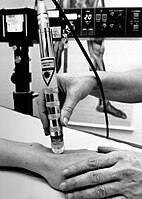
Photo from wikipedia
Among all the prevalent painful conditions of the shoulder, frozen shoulder remains one of the most debated and ill-understood conditions. It is a condition often associated with diabetes and thyroid… Click to show full abstract
Among all the prevalent painful conditions of the shoulder, frozen shoulder remains one of the most debated and ill-understood conditions. It is a condition often associated with diabetes and thyroid dysfunction, and which should always be investigated in patients with a primary stiff shoulder. Though the duration of ‘traditional clinicopathological staging’ of frozen shoulder is not constant and varies with the intervention(s), the classification certainly helps the clinician in planning the treatment of frozen shoulder at various stages. Most patients respond very well to combination of conservative treatment resulting in gradual resolution of symptoms in 12–18 months. However, the most effective treatment in isolation is uncertain. Currently, resistant cases that do not respond to conservative treatment for 6–9 months could be offered surgical treatment as either arthroscopic capsular release or manipulation under anaesthesia. Though both invasive options are not clinically superior to another, but manipulation could result in unwarranted complications like fractures of humerus or rotator cuff tear.
Journal Title: Indian Journal of Orthopaedics
Year Published: 2021
Link to full text (if available)
Share on Social Media: Sign Up to like & get
recommendations!